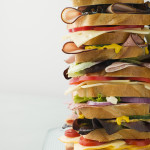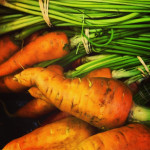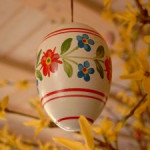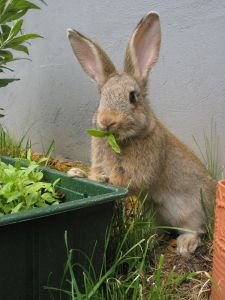A sandwich doesn’t have to be full of fat and calories. Replace high-fat mayonnaise with one of the reduced-fat varieties. You may want to stir in some chopped fresh herbs into reduced-fat mayonnaise for a flavor boost. You may also want to hold the mayo and spread your bread with mustard, as mustard is naturally low fat. You may also want to try a spread of non-fat yogurt mixed with a bit of mustard. Chutney, delicious by itself or when blended with mayonnaise or mustard, adds a sweet and spicy dimension to a sandwich.
Many lunch meats are high in sodium and calories. Look for alternatives such as grilled vegetables or skinless chicken breast, roasted turkey breast, or shrimp in a low-fat dressing. Another good alternative is water-packed tuna.
Cheese is a high-fat sandwich ingredient that should be eaten in moderation. Choose lighter cheeses such as Swiss or low-fat cheese.
Rather than ordering your sandwich at the deli counter, take a stroll by the salad bar. There are many candidates for a great sandwich just waiting to be piled onto bread (or into a pita) and drizzled with low-fat dressing.
A few healthy choice ingredients are: artichoke hearts, roasted peppers, pepperoncini, sprouts, shredded carrots, asparagus, sliced tomatoes, and tofu.
"Work With What You Got!"
© Victoria Hart Glavin Tiny New York Kitchen
Cooking is like love. It should be entered into with abandon or not at all. -Harriet Van Horne
Here are some super easy, but versatile Pasta Salad Ideas from Tiny New York Kitchen. All you need to do is add 3 cups of cooked & chilled pasta (of your choice) and 1 tablespoon of extra virgin olive oil to one of these inspiring combinations. Try them all throughout the summer for a whole treasure trove of side salads. If you want to make any of these a main dish then add 1 pound of protein such as grilled chicken breasts, grilled flank steak, grilled shrimp, grilled tuna (or canned tuna) or tofu. All recipes below serve 4.
For the Pasta: Cook 3 Cups of Pasta, Toss With 1 Tablespoon Extra Virgin Olive Oil & Then Chill Until Ready To Use. Add the Pasta to One of the Salad Combinations Below.
Nutty Beans & Greens
1 Cup Trimmed & Steamed Haricot Verts
1 Cup Baby Arugula
3 Tablespoons Toasted & Chopped Walnuts
1 Ounce Shaved Parmigiano-Reggiano Cheese
Snow Peas & Carrots
1/2 Cup Grated Carrot
1 Tablespoon Soy Sauce
1/2 Cup Thinly Sliced Snow Peas
1/2 Cup Shredded Red Cabbage
1/4 Cup Dry Roasted Peanuts
Cheesy Chickpea & Pesto
1/2 Cup Cooked Chickpeas
1 1/2 Ounces Crumbled Feta Cheese
1 Cup Halved Grape Tomatoes
1 Tablespoon Prepared Pesto
Mediterranean Medley
1/3 Cup Chopped Fresh Basil
1/2 Cup Thinly Sliced Cucumber
1 Cup Halved Cherry Tomatoes
1 1/2 Ounces Crumbled Feta Cheese
1 1/2 Ounces Sliced Kalamata Olives
Peppery & Nutty
1 Cup Arugula
2/3 Cup Thinly Sliced Radishes
3 Tablespoons Toasted & Chopped Walnuts
2 Ounces Crumbled Goat Cheese
Melon, Mint & Parm
1/2 Cup Fresh Cubed Cantaloupe
2 Tablespoons Fresh Mint Leaves
2 Ounces Thinly Sliced Prosciutto
1 1/2 Ounces Shaved Parmigiano-Reggiano Cheese
Freshly Ground Pepper
Cherry Almond Crunch
3/4 Cup Pitted Halved Fresh Cherries
1/4 Cup Toasted & Thinly Sliced Almonds
2 Tablespoons Chopped Fresh Basil
1 1/2 Ounces Crumbled Goat Cheese
Picnic Superstar
1/3 Cup Sliced Avocado
1/4 Cup Red Bell Pepper Strips
1/4 Cup Fresh Corn Kernels
2 Cooked Crumbled Center Cut Bacon Slices
2 Ounces Quartered Fresh Baby Mozzarella Balls
Easter celebrates the resurrection of Jesus, but is also associated with popular symbols such as eggs, candy, bunnies and food. Here is a look at the origins of these beloved symbols.
The Easter Lily
The white blossoms of the lily symbolizes the purity of Jesus. The trumpet-shaped flower that blooms in the spring also symbolizes new life and the resurrection of Jesus Christ. People use the flower to celebrate and enjoy the very essence of the Easter season.
Hot Cross Buns
A favorite during spring and the Easter season. Hot cross buns are a sweet, yeast leavened, spiced roll made with currants or raisins. They have long been a symbol of Good Friday. Each bun has an icing cross on top to signify the crucifixion.
The Butterfly
The butterfly’s unique life cycle is meant to symbolize the life of Jesus Christ. The first stage, the caterpillar, stands for his life on Earth. The cocoon stage portrays the crucifixion and the burial of Jesus. The final stage, the colorful butterfly, represents Jesus rising from the dead and the resurrection.
Easter Baskets
In Germany, children made nests in which the “Osterhase” or Easter Bunny could lay his colored eggs. The nests were replaced with baskets once the tradition was brought to the United States and the Easter contents were expanded to include candy and other treats.
Easter Ham
In the United States ham has become a traditional Easter dish. In the early days, meat was slaughtered in the fall. There was no refrigeration so the fresh pork that wasn’t consumed during the winter was cured for spring. This made ham a natural choice for the celebratory Easter dinner.
Easter Egg Hunts & Rolls
The first official White House egg roll took place in 1878 under the presidency of Rutherford Hayes. Egg hunts and rolls have no religious connection, but some will point out that the roll is a symbolic act for the removal of the stone blocking Jesus’ tomb.
Easter Parade
The origin of Easter parades dates back to the mid-1800’s in New York City. The wealthy used Easter as an opportunity to show off their new spring wardrobe by walking up and down Fifth Avenue after church. Soon the less fortunate started showing up to watch the spectacle and a tradition was born.
Easter Candy
Second only to Halloween in candy sales, Easter is a holiday for children and adults with a serious sweet tooth. Chocolate eggs and candy shaped like bunnies or eggs are extremely popular. Also, jelly beans are often associated with the holiday due to their egg-like shape.
The Egg
Easter eggs are likely linked to pagan traditions, but eggs have long been used to celebrate spring and the idea of renewal. It’s not unusual that in almost all ancient cultures, eggs are held as a symbol of life. At the Passover Seder, a hardboiled egg dipped in salt water symbolizes both new life and the Passover sacrifice offered at the Temple of Jerusalem.
The Easter Bunny
The cute furry creature is certainly not mentioned in the Bible, but has nonetheless become the most well-known symbol for the spring holiday. The Easter Bunny’s origins are not entirely known, but some stories date his arrival in the United States back to the 1700’s when German immigrants brought their tradition of an egg laying hare called “Osterhase” to the country. Much like children leave cookies for Santa, boys and girls leave carrots out for the Easter Bunny in case he got tired from hopping around all night.



















